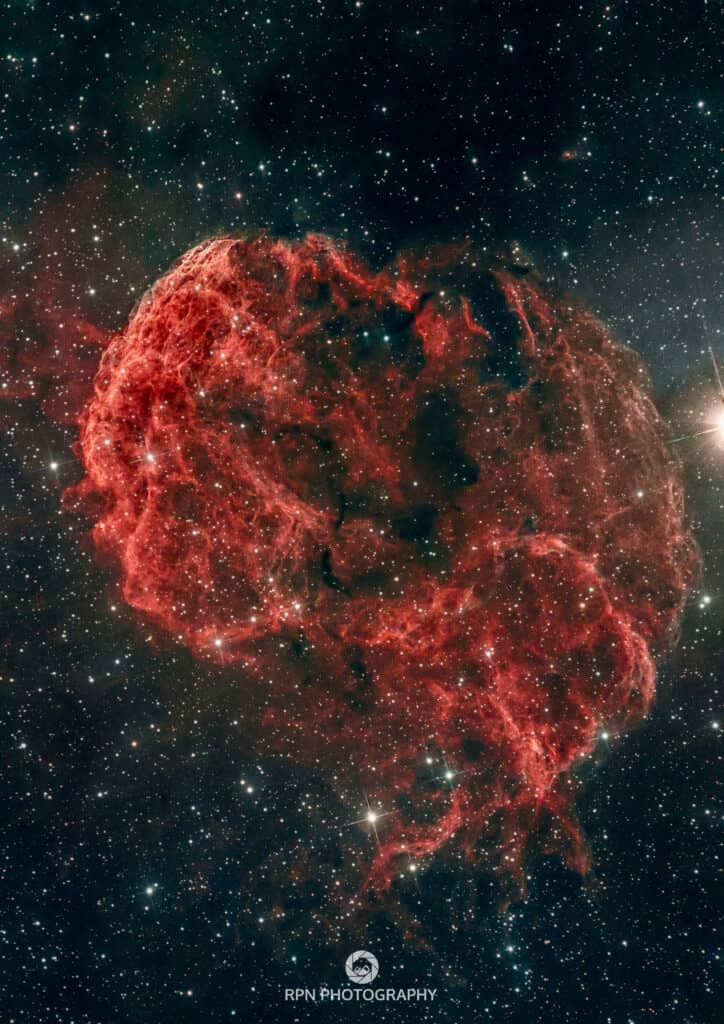Well folks, we said farewell to astronomical darkness at the end of May, so it will soon be time to turn our attention to the planets in our solar system to explore through our telescopes.
Exciting update; I have now acquired some additional equipment including a planetary imaging camera so hopefully I might be able to start capturing some planetary, solar and close- up lunar surface images myself.
Watch this space (yes, that pun was unintentional)!
This month I was planning to share the M13 Globular Cluster, but unfortunately the image I tried to capture didn’t quite cut the mustard. So instead I’m going to share with you this rather impressive supernova
remnant captured a couple of months ago.
Last month I shared an image of a brand new supernova just starting to occur. However IC443, also known as the Jellyfish Nebula, shows what a supernova looks like after thousands of years, with this stunning blast
wave of gas and dust. IC443 is around 70 light years across and 5000 light years from Earth.
This image was captured using my bigger Sky-watcher Newtonian Reflector Telescope and Cooled Astro Camera.
The night sky, June 2022 – Rob’s guide for your stargazing this month:
Inevitably, this being the UK, those of us who got up super-early to try to watch the total lunar eclipse in May were thwarted. Mother Nature naturally decided to obscure our view with clouds and rain.
However in June we do at least have a chance to see the second supermoon of 2022, which is only one per
cent smaller than the biggest supermoon event coming up in July. A supermoon occurs when the moon’s orbit is closest (perigee) to Earth at the same time it is full.
On the 14th of June, the supermoon will hopefully reveal itself, so grab those binoculars or a telescope and
have an explore of the detailed lunar surface across the entire visible face of this full moon.
Summer solstice
The planets aren’t currently visible in the evening skies, but do wake up early to see a beautiful procession of the planets before dawn.
On the 21st June, the bright ‘star’ seen nearest to the Moon will be Jupiter. Also on the 21st of June at 10:13am we witness the Summer Solstice. The sun will reach its northerly-most point in the sky, marking the
Midsummer’s Day, with the longest period of daylight and shortest night. On the 22nd June, before dawn, look to the right of the Moon to see Jupiter, with Mars flanking from the left.
On the 23rd June, also before dawn, Mars will switch positions and be visible to the right of the Moon. On the 26th June, Venus alongside the crescent moon make a picture-perfect arrangement with the Pleiades
visible above if observing with binoculars. Mercury will also appear, completing the arrangement to the lower left. Wake up early again on the 27th June (it’s clearly a month of early starts) to reveal a very thin crescent Moon, with Venus visible to the right, and Mercury below.
Summer Solstice
The summer solstice, also known as estival solstice or midsummer, occurs when one of Earth’s poles has its
maximum tilt toward the Sun. It happens twice yearly, once in each hemisphere (Northern and Southern). For each hemisphere, the summer solstice is when the Sun reaches its highest position in the sky (for areas outside of the tropics) and is the day with the longest period of daylight. Within the Arctic circle (for the northern hemisphere) or Antarctic circle (for the southern hemisphere), there is continuous daylight around the summer solstice. Since prehistory, the summer solstice has been seen as a significant time of year in many cultures, and has been marked by festivals and rituals. Traditionally, in many temperate regions (especially Europe), the summer solstice is seen as the middle of summer and referred to as “midsummer”.
by Rob Nolan – Find RPN Photography on Facebook here


